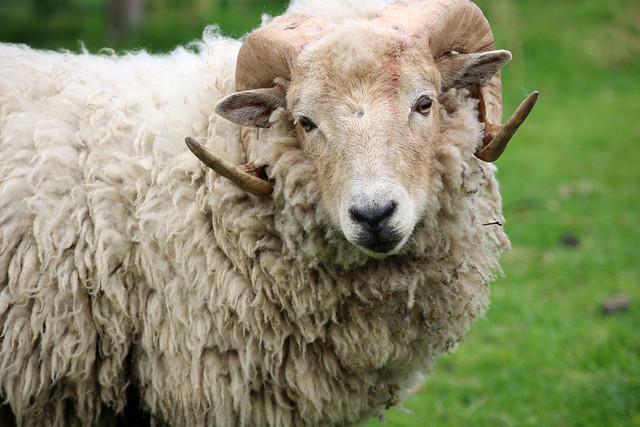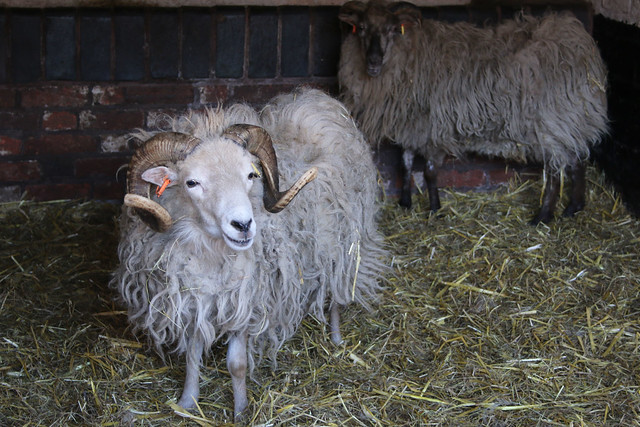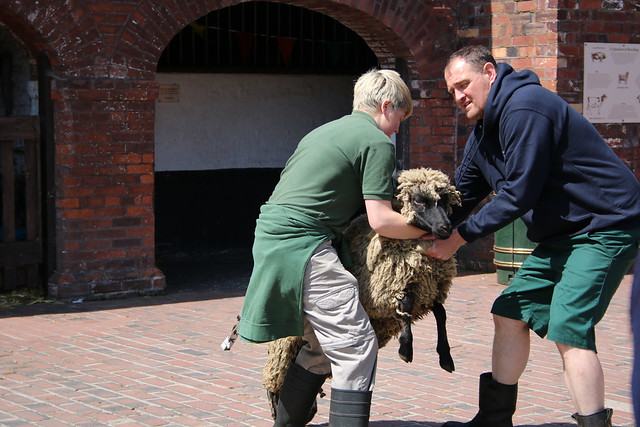In the last few weeks, I’ve had the chance to take part in a few sheep/wool related events due to being a member of the Birmingham Guild of Weavers, Spinners & Dyers.
A couple of weeks ago, I spent Bank Holiday Monday visiting Harcourt Rare Breeds. The Harcourt flock is split over two sites, with one of those sites relatively local to me in Market Bosworth, and the other in Harrogate. The Midlands flock is housed in the ‘back garden’ (fields behind the house) of owner Shaun, so it was very kind of Shaun to welcome some members of our Guild into his home for lunch, and into his garden to meet the sheep.
Suitably enough, to reach Harcourt Rare Breeds we traveled through the parish of Sheepy, which contains the villages of Sheepy Magna and Sheepy Parva. As you can guess from their name, Harcourt specialise in rare breed British sheep, including Border Leicester, which look like overgrown rabbits due to their upright ears, and Leicester Longwool, which have a beautiful long silky fleece.
Harcourt Rare Breeds sell both fleeces and prepared yarn. Since I still haven’t (nearly) finished preparing the last fleece I bought, I instead came away with three skeins of Leicester Longwool yarn. Shaun also gave each of us a goodie bag of fleece! I selected Leicester Longwool fleece, and you can see the before and after shot of the fleece and prepared yarn from the flock below.
There are quite a few lambs in the flock currently, and one came into the house to visit us to our delight.
The next outing we had as a Guild was to visit Wooly Week at Sandwell Park Farm. I wasn’t aware of the Farm before but will definitely visit again, it’s located in a restored Victorian farm, with lovely walled kitchen gardens, a tea room, and a number of rare breed animals.
Shearing demonstrations were taking place throughout the day, and my Guild were attending to demonstrate the process of preparing the fleece to produce yarn. The rare breed animals on the farm include a couple of sheep from a traditional breed (pictured below, the name of which I’ve forgotten) which malts its fleece, rather than requiring shearing.
Finally, last weekend my Guild ran a Back-to-Back Challenge at Lickey Hills Visitor Centre. My understanding of the history of the Back to Back Challenge, is that the initial inspiration for the challenge is the Newbury Coat. In 1811, in the village of Newbury, a Baronet allegedly made a large bet that a local mill owner could produce a tailored coat in one day. In thirteen hours and ten minutes, those involved sheared a sheep, washed, spun and wove the wool into cloth, the cloth was then scoured and dyed, and finally tailors cut and sewed the cloth into a formal hunting coat. The Baronet sat down to dinner wearing the coat at the end of the day.
The original Newbury Coat challenge celebrated contemporary developments in mill machinery, but in 1992 the Back to Back Challenge was created to raise funds for charity by producing a hand-knit sweater from a fleece in a day (I believe the World Record is less than 5 hours). Official Back to Back Challenge entries need to follow set rules, so our Guild Back to Back challenge was more informal. Rather than starting by shearing a sheep, we started with a local Romney fleece, unwashed but pre-sheared. Participation was open to all interested members of the Guild, with everyone contributing depending on their skills/preference, including carding, spinning, plying, and lots of knitting. My spinning skills are still very basic, so I carded until yarn was available and then mostly knitted.
We didn’t quite complete a full garment during the day (our event took place from roughly 09:30-05:15), but we got very close, with just a little knitting and seaming left to do to complete an adult’s oversized cardigan, from a pattern designed by a member of the Guild.



















